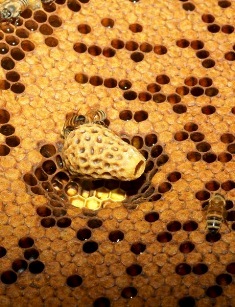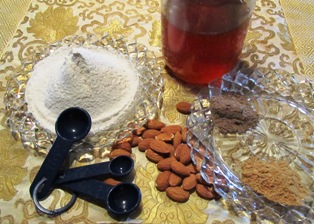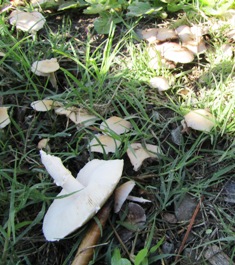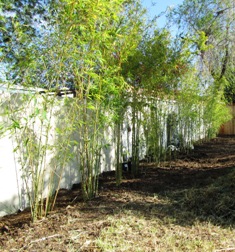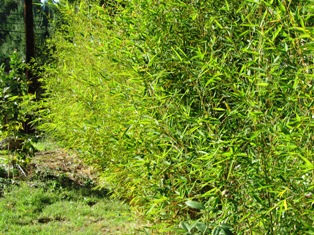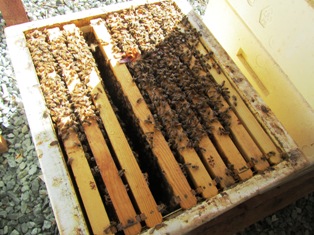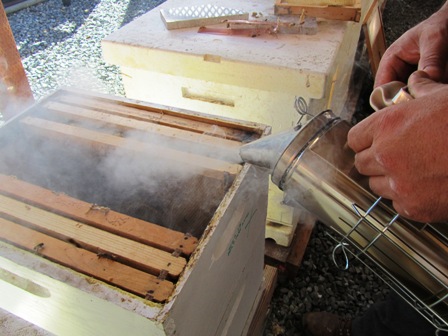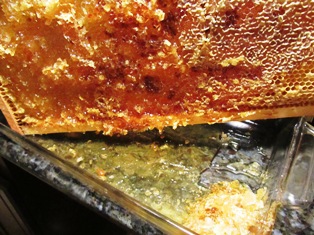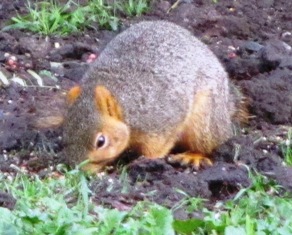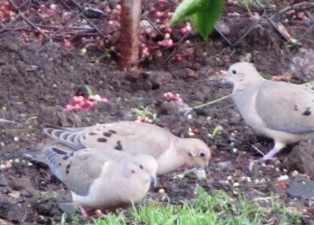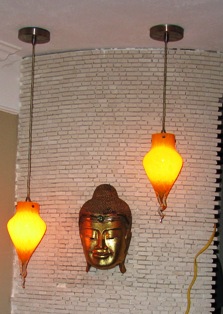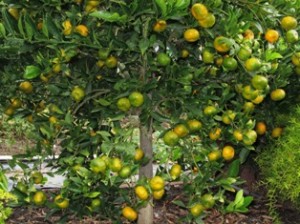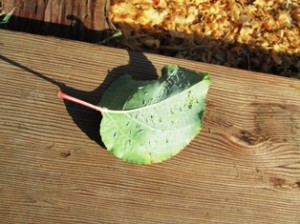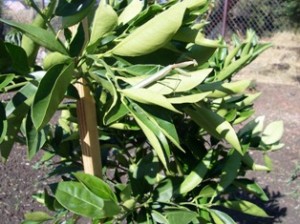Archive for November, 2012
A Kitchen Created from Gifted and Discarded Materials
Built in 1947, the Henny Penny Farmette cottage didn’t look like a dream home when we first saw it. However, we knew we could make it not only habitable but functional and pretty. There had been a family living there before we purchased the property. They left behind some kitchen cabinets but that was about all.
At one point the house had some pretty hardwood flooring. I know this because I met a neighbor who bought it from the family who lived here. Apparently, most of the interior that wasn’t nailed down was sold or otherwise removed. When we got here, there was no bathroom sink or appliances (unless you count an old refrigerator standing abandoned on the land).
Bathroom and kitchen became construction priorities for us. From a retail marble outlet, we secured permission from the owner to take what we wanted from the store’s dumpster. We found enough discarded marble to create a guest bathroom floor in one color and a master bathroom floor (in two colors). It meant my husband Carlos would have to painstakingly cut the tile, but he was up to it.
We found marble countertops discounted by a supplier in Oakland. We also discovered that the supplier had some pieces in a discard pile (for a fraction of the cost but he would only sell it on Sundays) requiring us to make another trip. We like the “L” shaped counter, but had to cut the holes for the sink and cooktop. Carlos created a beautiful sunburst as the focal area on the wall behind the cooktop.
We discovered a closeout sale on Italian honed marble but had to drive for two hours to Sacramento to get it. The price was great but the speckled marble was rather plain. I asked Carlos to cut some rectangles in the same color as the sunburst and we played around with different patterns finally settling on a simple one.
It has taken almost three years for Carlos and I to finally finish the kitchen (although we haven’t been working on it full-time, there are other tasks around the farmette that must be done, too). We are pleased with the result.
Our refrigerator and dishwasher do not match the other appliances that we have in the kitchen, but they were gifts that we will use until we need to replace them. We got the remainder of the appliances (all stainless steel) at a fire sale price for the lot from a friend going through divorce. But the kitchen is quite functional. Best of all, we did it for a fraction of the cost of a kitchen remodel at today’s prices and in the process kept materials out of landfill.
The Inherent Gifts of Observation
I saw some wild turkeys today strolling through the acre behind the farmette. If I hadn’t noticed them, I wouldn’t have captured them on film. They disappeared as quickly as they showed up. You have to pay attention for the moment is soon lost.
Some people never lose that childlike wonder of noticing everything in their environment. My grandfather was like that–a veritable treasure trove of information based on the observations of his world. An attitude of gratitude seems to come easily to such individuals, as if noticing and feeling thankful are linked.
The Buddhist practice of mindfulness suggests that kind of noticing. For example, if you spot a flower while out walking (perhaps it even grows through a crack in the sidewalk), you might bend down to examine the flower. Does it offer a fragrance, beauty in its perfect symmetry, a ladybug on it’s stem, delicate leaf, or a gentle sway in the breeze as if it is dancing? These are the gifts the flower offers, the gifts it holds for you when you take the time to notice.
I like working with the bees and seeing up close their world within the hive. I had never seen a “queen house.” When I did for the first time I felt astonishment at how perfectly functional it was. Honeybees create comb to seal in the honey–their food (and ours)–and these honeycombs and queen houses are functional, perfectly formed, and beautiful to gaze upon.
For my grandfather (and also in my own experience) observing nature’s glory conjures feelings of appreciation for so many blessings–the ability to see, hear, feel, touch, think, and sense what is present, what co-exists around us. This renders the perspective that we humans are mere specks in cosmic creation.
Our lives are richer when we appreciate what we have and take time to notice how richly adorned our lives are.
Old World Honey Cake
Honey cake has been called the world’s “oldest-known cake.” Versions of the cake date to biblical times, although food historians will tell you that it wasn’t really called cake back then. The English term “cake” dates to the thirteenth century and derives from the old Norse word, “kaka.”
Modern pastry chefs have the ancient Egyptians to thank for pioneering the culinary process of baking. The ancients’ version of honey cake was most likely an old-world type of flat bread drizzled or lashed with honey, the sweetener of choice during ancient times. In fact, bread and cake (even today) are not too different. Think of pumpkin bread or banana nut bread. A slice of either at breakfast is like having dessert in the morning.
The Romans added eggs and butter to get a lighter dough. Cooks began to add nuts and dried fruits such as dates, figs, and raisins to make their honey “cake” even more mouth-watering and special.
Although that round shape that we associate with cake today didn’t emerge until the seventeenth century, medieval bakers in Europe had for centuries continued to create new versions of the honey cake with spices such as ginger. In fact, the taste for ginger resulted in gingerbread. The addition of dried fruits, nuts, spices, and (later) rum and brandy yielded the cake we know today as fruitcake.
The following recipe is more of a medieval style honey cake, although during the medieval period cakes tended to be smaller than we think of them today.
Old World Honey Cake
Ingredients:
1 cup plus 1 tablespoon honey (preferrably dark)
1 teaspoon cinnamon
1/2 teaspoon ground nutmeg
1/2 teaspoon cardamom
2 teaspoon baking soda
1/2 cup softened unsalted butter
1 cup dark brown sugar
4 eggs (separate yolks from whites)
1/2 cup unflavored Greek yogurt
1/2 cup cottage cheese
1 tablespoon fresh orange zest
2 1/2 cups flour
1/2 teaspoon salt
1/2 cup raisins
10 dates, stoned and chopped
1 cup walnuts, finely chopped
Directions:
Preheat the ove to 300 degrees Fahrenheit. Grease a ten-inch tube pan.
Combine honey, cinnamon, nutmeg, and cardamom in a saucepan over medium high heat and bring to a boil, stirring often. Add baking soda, stir in, and remove from heat and let cool.
In a mixing bowl, cream butter with brown sugar. Beat in one egg yolk at a time. Add this to the honey/spice mixture.
In a bowl, mix yogurt, cottage cheese, and orange zest.
Sift half the flour and the salt into the honey/spice mixture (that now also contains the creamed butter, sugar, and eggs). Combine remaining flour with raisins, dates, and walnuts. Mix this into the bowl of batter.
Pour the batter into the greased tube pan and bake for 1 1/2 hours. Test for doneness by inserting a toothpick into the cake. The toothpick, when pulled out, should have no batter on it.
Cool the cake for 15 minutes before inverting. Brush with 1 Tablespoon of honey.
Optional: Sprinkle with slivered almonds. After the cake is completely cooled, store in an airtight container for 24 to 48 hours before serving.
Copyright Meera Lester 11-28-2012
Is It a Mushroom, Morel, Truffle, or Toadstool?
I wouldn’t call myself a gastronome when it comes to mushrooms–my taste and enjoyment of them is not that discriminating. I like them in food, but I am not fond of finding them popping up all over the farmette after a rain. My displeasure at seeing them in the lawn, around the raised planter boxes, on the pathways, or in the orchard and garden stems from my not readily knowing which types are beneficial s and which are harmful. There are literally hundreds of different species, some are poisonous.
The mushroom (often called a toadstool) is the visible sign of the presence of a fungus in the soil. The toadstool generally has three parts–a stalk or stem, a cap, and gills. You might think of the hookah-smoking caterpillar perched on top of one in Alice’s Adventures in Wonderland, by English author Lewis Carroll.
Mushroom color varies with the species of fungus that produces the fruiting body. While many have neutral coloring, some, like the poisonous fly agaric (Amanita muscaria) that you would find in the woods associated with conifer and birch trees, has a brilliant red cap with white scales.
Don’t eat mushrooms or toadstools you find growing in the wild unless you are an expert on fungi.
The majority of fungi won’t harm the garden (although some do). If I don’t recognize the type of fungi that is growing, I either ignore them or use a spade to dig them out. I dispose of them in the garbage. Some toadstools are actually beneficial to the soil, adding back in certain nutrients. Such fungi have a symbiotic relationship with garden plants. However, others can have spores harmful to humans.
I’ve used a lot of soil amendment and compost on the property. There may be pieces of rotting wood buried under the dirt. Fungi need a food source to grow. In packed soil and the damp conditions following a rain, toadstools pop up, seemingly everywhere.
Alas, I cannot as yet tell the toadstool from the truffle or morel, so highly desired in the French and English culinary traditions, so I won’t eat any of them. And as for sitting on one, well . . . I leave that for the hairy worm of Lewis Carroll’s imagination.
Bamboo Transforms Stark into Lush in No Time
New to the neighborhood and homesteading, we were offered a patch of clumping bamboo that was growing on the land behind us when we first moved to the Henny Penny Farmette. We worried as many do about the spreading habit of bamboo. The last thing we wanted were neighbors complaining that it had sprouted onto their property.
Back then rotting fences lined the boundaries of our land. The house, too, was in decrepit condition, but Carlos and I saw the potential of the property. We also liked the idea of natural fences or at least plants to soften the stark look of all those boards. Bamboo, we reasoned, made good sense: it was drought tolerant, easy to care for, and quick growing. It could turn a stark, ugly fence into a lush privacy screen in no time.
The vibrant green color turns to a golden amber in the fall and the plant (related to grass) moves gracefully in the wind. The plants were mainly clumping types of bamboo so they were not as likely to spread like thistle in the wind. When we were at the local DIY store, we checked the price of bamboo in pots and quickly realized that the gift we were to receive was worth several thousand dollars.
With shovels in hand, Carlos and a worker began digging along one long fence line on our property. After the planting holes were prepared, he and the worker used the wheel barrow to transfer the bamboo from the back property to ours. The two men planted and deeply watered the bamboo.
Winter rains in 2011 helped the bamboo take hold. It grew well the first year with a little extra watering over the summer. The next rainy season again fostered new growth. Now we have a verdant green fence line of thriving bamboo.
The Seductive Taste and Smell of Honey
The sweet, seductive scent of honey permeates the rear of my property where the honeybee traffic has picked up now that we have had a few warm days. My neighbor Peter told me on Saturday that we would open the hives today. I enjoy helping him with bees, and my organic yogurt wouldn’t taste the same without that sweet honey drizzled on top.
Peter says it’s coming on winter now and the bees need food. Sources of pollen diminish during fall and winter. Our inspection will determine whether or not the bees and their hives are in good shape. Most likely, if there is honey, we won’t harvest it but rather leave it for the bees. Still . . . if there’s an abundance, we might take a frame or two.
When he was just a boy, Peter received his training as a beekeeper from his father. His father’s honeybees kept their Lebanese village supplied with honey. Our purpose in opening the hives today is to inspect the physical structures of the hives for mold, mites, ants, or any foul smell that might suggest a problem.
We last medicated the bees during the first week of October. This morning, the bees were so docile, Peter didn’t even suit up. But I did. Even so, the last time I put on the head-to-toe bee suit and the elbow length leather gloves, I still got stung as I was removing the suit.
At approximately 9:30 a.m. , we started to open the hives, smoking each one, in turn and closely checking each frame. The hives all looked healthy and robust. We removed spent containers of Apigard and the hanging sticks of antibiotic.
After inspecting each frame in each hive, we re-medicated the bees to ward off mites and anything that might attack or weaken the immune systems of the bees. The goal is to keep them healthy and strong so that the honeybees survive with their babies through the winter to swarm in the spring (swarms are the way the bees expand their populations).
The last three hives were particularly strong. The bees were busily working. Each super (styrofoam box or hive that holds ten frames) was heavy. We reduced the sizes of the hives to two supers instead of a stack of three on top of each other. Smaller hives during the winter means less work for the bees to stay warm and make babies.
Peter handed me three frames of honey to take to my kitchen. He also took a frame or two. Tomorrow, I’ll make a honey cake . . . if I can stop myself from constantly sampling the gorgeous colored, sweet tasting honey that slowly drips from the frames into large glass dishes in my kitchen.
Serve Up Seeds for Furry and Feathered Creatures
Squirrels can contort their bodies into bizarre and exotic positions just to get at the seeds in a bird feeder, as any wildlife watcher can tell you. But they aren’t crazy about all birdseed. Safflower is a good example of a seed loved by birds but not squirrels. The squirrels will forgo a whole feeder of that seed in order to dine on sunflower hearts that is also a favorite of chickadees, finches, and woodpeckers. Pesky squirrels will also paw through a bird feeder to eat other seeds mixed into a commercial wild bird feed but still pass on eating the safflower if it is present.
Since both squirrels and many species of wild birds love sunflower seeds, we grow several types throughout the summer. When fall approaches, we place the dried heads of the sunflowers in an area away from a bird feeder to attract the squirrels and hopefully limit their foraging of food intended for the feathered wildlife. Sometimes it works. However, mourning doves are ground feeders and so are quail. We’ve found the squirrels and the birds foraging together for sunflower seeds.
A squirrel and mourning dove share a meal
The finches enjoy the black Nyger (or thistle) seeds so we keep one feeder of that seed just for them. We love the splashes of yellow (the coloring of their breasts) as they flit around and perch on the feeder to devour their favorite meal. But other birds with small bills like the California quail, pine siskins, towhees, dark-eyed juncos, song sparrows, and purple finches also are attracted by Nyger seeds and will dine often if the feeders are kept filled.
Squirrels and some types of birds particularly enjoy pumpkin seeds and peanuts, so we also put those out when the weather becomes bleak and we’re pretty certain that the wildlife around us isn’t finding much food. During those periods, we also hang suet for the birds, especially those that hang around for the winter but don’t have a lot of food choices such as crows, robins, and the American goldfinches.
When you ensure adequate food supply for the furry and feathered creatures in your backyard, you will be rewarded with many entertaining and heart-warming images. Keep your camera handy for capturing squirrel contortions or surprising pictures of who dines with whom.
Let There Be Light–In the Kitchen, At Least
A new project seems to beckon at every turn here on the Henny Penny Farmette. But as we anticipated having our first celebratory meal at Thanksgiving in our farmette kitchen, we decided to make working on the interior of the house a priority. Well, not the whole house. Technically, I mean the kitchen/dining room/living room space. Although it’s the size of a postage stamp, the space affords easy flow.
At roughly 600 square feet, the farmette kitchen/dining room/living room space at times has felt tight, cluttered, and dark. But after we moved out some boxes (yes, still unpacked from two years ago) into a storage shed and thoroughly cleaned the area, the room seemed more expansive. A few days before Thanksgiving, Carlos and I addressed the lighting problems.
We needed light over the long granite counter that separated the kitchen from the dining area. We also had a very dark area at the end of the counter, space that sort of recessed back into an area that we use as extra kitchen storage and wet bar.
Our so-called “art” wall, tiled in stone (the wall is shaped in a half circle), that could use soft illumination. Finally, the living room had no lighting (although at one point, a single naked bulb hung from the ceiling). If we actually wanted to see our guests, that area needed attention.
We picked three areas (foregoing the living room for now, although we do have a plan for it). Four yellow glass pendant lights went in over the counter. Two yellow blown glass pendants were hung near the art wall. A crystal chandelier that hearkened back to the elegant ballrooms of the 20s and 30s was hung above the dining table. With the lighting finished and much to be thankful for, we sat down and enjoyed our Thanksgiving dinner. That was when I noticed the floor…still no flooring. Argh! Like I said, a new project at every turn.
Pest Control
A rain storm threatens to blow in over the Northern California coastline but here in the shadow of Mount Diablo, the wind is warm, the sky is blue, and the birds and bullfrogs are singing. I have to grout the kitchen counter backsplash and otherwise prepare the farmette for Thanksgiving, a goal I set at the beginning of the year. But this morning, I feel inspired to stroll through the garden to inspect my still-blooming roses, pluck and devour a strawberry or a ripe fig, or sample the mandarin oranges from the heavily laden tree. What could possibly ruin the start of such a beautiful day?
Pests, that’s what! I found colonies of aphids on the underside of the leaves still hanging onto the young apricot trees. Scrutinizing the underside of the leaves on the orange tree, I found ants inching up the trunk. That suggests to me there is a food source in the tree for those ants. So now I have deal with pests before starting the kitchen grout work.
Pests and gardens go together. I might not be able to eliminate the pests, but at least I can control them. I like an integrated control approach to dealing with pests. For example, I try not to plant all of one type of plant or tree in one area–that’s just inviting trouble in the form of pests that attack that type of plant. Also, I’ve included different varieties of the same type of plant like an apricot and a apricot/plum hybrid called an aprium tree. When I see leaves on my roses or trees with aphids, I pick the leaves off and put them in a bag (not the compost pile) to dispose of them.
My heart feels lighter when I spot a praying mantis in the garden for these amazing little creatures love to eat moths, flies, grasshoppers, crickets, and other annoying little pests. In fact, I like to introduce populations of helpful insects to compete with pest population. Green lacewings or “aphid lions” devour aphids, lots of them, but they’ll also dine on spider mites and mealybugs. Ladybugs (more correctly, “Ladybird Beetles”) are also a favorite of mine since they eat aphids, mites, and scale insects.
Spiders trap mites and pesky insects in their webs and I feel fortunate to have many in my garden. Occasionally I see those shiny black beetles known as Ground Beetles but don’t handle them because they stink. However, they can serve as a veritable hungry army against cutworms and the larvae of other pests in the garden.
I don’t like poisons or insecticides, but I will mix soap with water to spray some plants. Companion planting, or the growing of plants in close proximity for both plants’ mutual benefit, such as enhancing soil nutrients and discouraging harmful pests, is another way I control pests. So while I would love to enjoy my early morning, I think I’d better get to work on the pest problem now. The grouting can wait. There are still two days before Thanksgiving.
Inviting Nature in through a Kitchen Garden Window
At only 1,000 square feet, our farmhouse, at times, felt claustrophobic to me after we moved here in 2010. I needed windows and lots of light. I wanted hardwood floors and granite countertops. But I also wanted to reuse, recycle, and do the work as inexpensively as possible. My husband Carlos is an architect and I’m his number one (dare I say visionary) helper. Together we’ve done remodels on both coasts, so a little farmhouse should be no problem, right? We had no idea how much work was (and still is) ahead of us.
Fans of network television home improvement shows will tell you that if you ever want to make your money back on a renovation, fix the kitchen and the bathrooms. So, of course, those were high on our list of priorities. Rotting wood and mountains of broken ceramic tile had to be carted away before we could even start our interior work. But we did put in a marble kitchen floor. Carlos laid it out in a pretty pattern. It looks lovely, is easy to keep clean, and feels cool under bare feet in the summer.
Finally, we began to slowly and methodically open up the space. Inside the kitchen, we installed the back splash of Italian honed marble that we bought at a closeout sale. We reused the garden window. For me, windows are a lovely way to link indoor with outdoor space. Framing the window and adding a flourish of crown molding finished it off nicely. Now I can look out on a maple tree, roses, and lavender planted along the fence line when I do dishes. Anchored in front of that window, I incubate my ideas for my books and dream of what renovation project to tackle next.
 Facebook
Facebook Goodreads
Goodreads LinkedIn
LinkedIn Meera Lester
Meera Lester Twitter
Twitter










